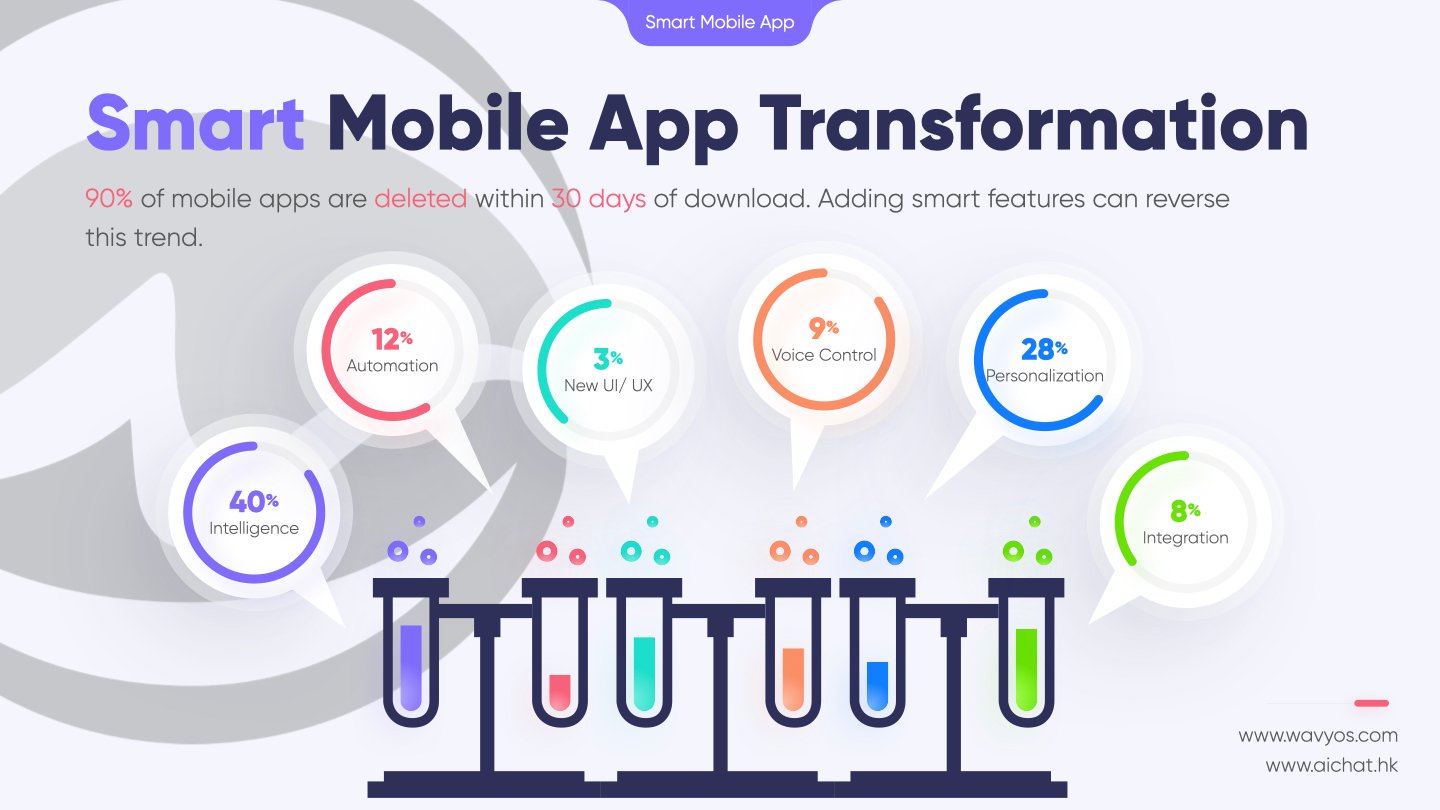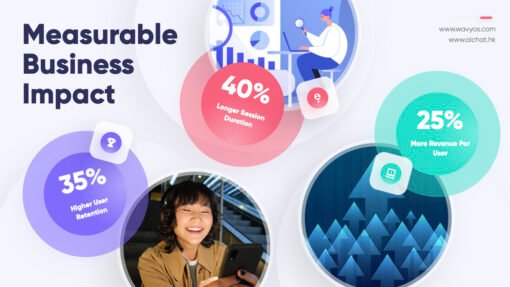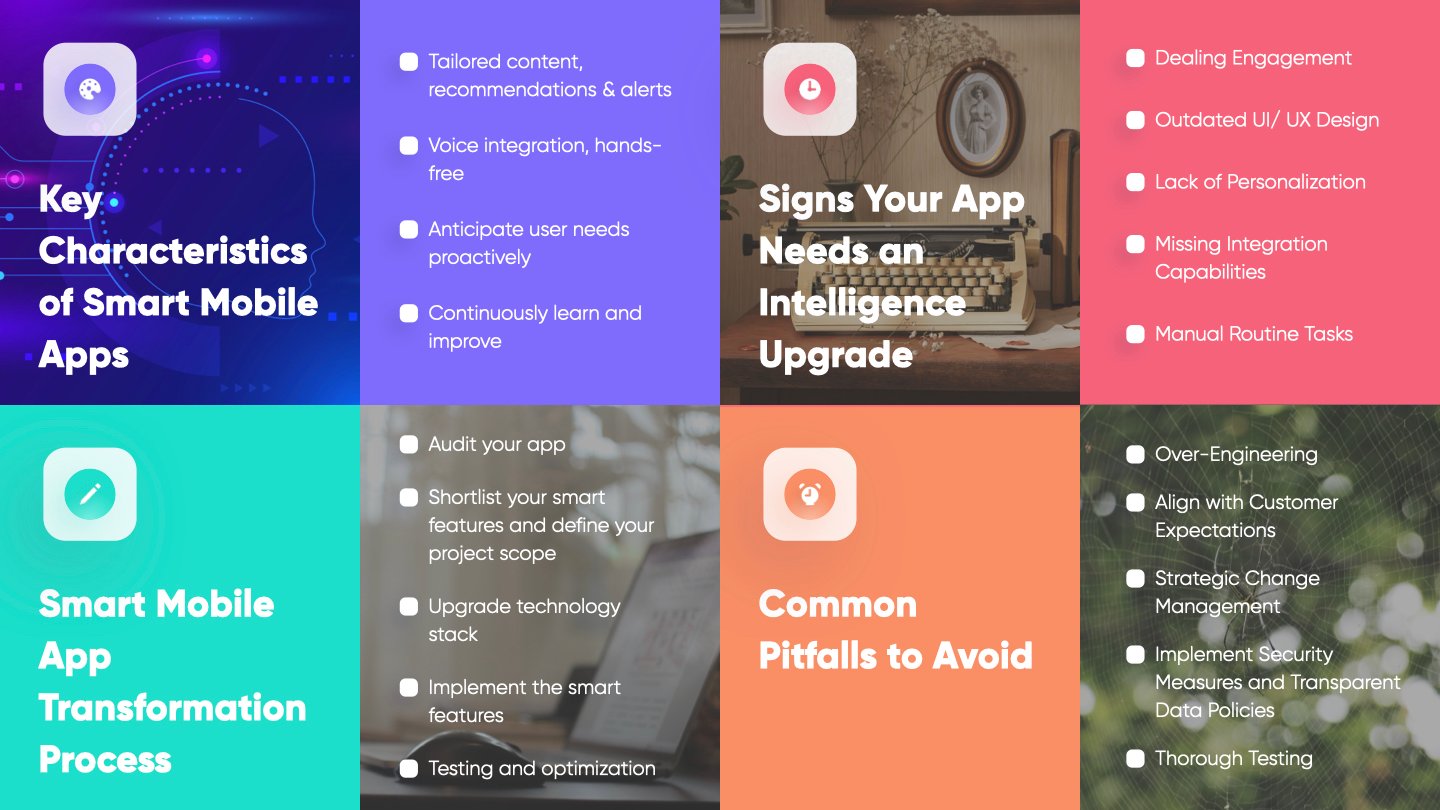How to Transform Your Old App into a Smart Mobile App?

Why Apps Need AI to Survive
Given that 90% of mobile apps are deleted within 30 days of download, outdated functionality and poor user experience guarantee failure. If your app shows declining ratings or dropping engagement, it’s time for a serious review. In today’s AI era, simply having a mobile app isn’t enough. Your app needs to be intelligent.
AI-powered smart mobile apps deliver intelligent features and more personalized experiences that adapt, learn, and evolve with user behavior. They are revolutionizing how users interact with your brand and transforming them into engaged customers.
The stakes couldn’t be higher. Even tech giant Apple’s (AAPL) stock performance is lagging the market due to falling behind in AI development. Some investors are questioning whether it could become another BlackBerry. The message is clear. Integrate AI now or risk becoming a relic of the past. In a world where the bar for user expectations keeps rising, AI isn’t just an advantage. It’s essential for survival!
The good news? You don’t need to start from scratch. In this article we’ll walk you through the strategic process of upgrading your existing app into a sophisticated, user-centric smart mobile application that increases user retention while driving higher lifetime value.
What Makes a Mobile App “Smart”?
Unlike traditional apps that offer static features, smart apps leverage artificial intelligence to create personalized, adaptive experiences.
Key Characteristics of Smart Mobile Apps
Smart mobile apps use AI-powered personalization to deliver tailored content, recommendations, and alerts based on individual user habits. Voice integration enables hands-free task management. Users handle routine tasks and updates like scheduling and data entry without even opening the app. And the most intelligent interfaces anticipate user needs proactively. iOS, for instance, suggests relevant apps to open when users unlock their phones. Through real-time adaptability, apps continuously learn and improve from every interaction, creating an increasingly personalized experience.
These smart features appear in popular apps across industries. Spotify curates personalized playlists from listening history, while Netflix’s recommendations drive 80% of viewer engagement. Banking apps detect fraud instantly through predictive analytics, and Google Maps suggests optimal departure times based on traffic and calendar events. Fitness apps like MyFitnessPal learn dietary preferences to streamline food logging and provide tailored nutrition insights.
Measurable Business Impact

The business impact is significant. In general, smart apps achieve 35% higher user retention, 40% longer session duration, and 25% more revenue per user. As with any business, when apps understand user needs and provide a positive experience, people tend to use them more frequently. This creates a competitive advantage that drives measurable business growth.
Signs Your App Needs an Intelligence Upgrade
Several indicators signal that your app requires an intelligence upgrade to remain competitive and user-focused.
Declining engagement metrics serve as the primary warning sign. When you notice reduced session duration, fewer daily active users, lower retention rates, and increasingly negative user reviews, your app is losing its appeal to users.
Although user interfaces are becoming less the center of smart mobile apps, outdated UI/ UX design remains a critical issue. If your interface appears dated or users struggle with navigation, it’s time for a redesign. To find out whether you need cosmetic UI design touch-ups or a complete structural overhaul, you need to define clear business goals and analyze user pain points to see what really makes sense.
Another sign is lack of personalization. This is common in today’s apps. Users expect more than theme color changes. They want intelligent search results, smart recommendations, and content that adapts to their behavior and preferences. If your app fails to proactively suggest relevant information, you’re underutilizing AI’s potential.
Integration capabilities are equally important. Modern apps must integrate seamlessly with operating systems and other applications to fully leverage their latest features and data, thereby enabling intuitive controls and contextual intelligence.
Finally, manual processes and security vulnerabilities that intelligent systems could handle represent clear opportunities for improvement. Automating routine tasks and implementing AI-powered security measures will significantly enhance both performance and user experience.
Step-by-Step Smart Mobile App Transformation Process
Step 1: Audit Your Current App
Begin your smart mobile app transformation with a comprehensive audit of your existing application. Start by analyzing user feedback and app store reviews to identify common complaints and popular feature requests. Then, review key performance metrics such as crash reports, load times, and retention rates to understand where users drop off.
Evaluate your app’s features against competitors and emerging AI offerings to uncover specific weaknesses. Outdated components and deprecated APIs can compromise performance and security. So conduct a technical assessment to ensure your codebase is up to date.
This audit will lay a solid foundation for your transformation, addressing both user-facing issues and technical challenges that could hinder future growth.
Step 2: Shortlist Your Smart Features, Prioritize Them and Define Your Transformation Scope
Identify high-impact opportunities where AI can enhance your app based on your audit findings. Look into these areas: repetitive tasks, decision-making processes, personalization, and automation across your app ecosystem. Clearly distinguish which features require upgrades versus full transformation. Then prioritize features that align closely with business objectives and offer measurable ROI.
And to drive quantifiable outcomes and informed decision-making, establish and track KPIs for each feature. Common KPIs for mobile apps include user growth rate, retention rate, churn rate, daily active users (DAU), monthly active users (MAU), session length and conversion rate. There is one point always overlooked too. Develop a phased implementation roadmap to mitigates risks, focus and aligns with your strategic goals and technical capabilities.
Step 3: Technology Stack Upgrade
A technology stack upgrade modernizes your app’s software and hardware infrastructure to support intelligent features. Without these upgrades, outdated apps cannot handle real-time analytics, IoT integration, personalized interfaces, automated processes, or other advanced functionalities.
Essential upgrades include cross-platform frameworks, cloud-native architectures, API-first approaches, scalable databases, robust caching strategies, and comprehensive security measures.
While we won’t cover all technical details here, consider frameworks like React Native or Flutter. These tools provide improved performance, shared codebases, and access to current mobile capabilities alongside seamless integration of AI libraries and third-party services.
Step 4: Implement Smart Features for Legacy Mobile Apps
Building on the previously discussed technology stacks, consider these key features for enhancing legacy mobile apps:
- AI-Driven Personalization: Tailors content and recommendations to user preferences, like Netflix’s suggestion algorithms, boosting engagement.
- AI Customer Service: AI Customer Service or AI Chatbots provide real-time assistance, addressing queries efficiently and improving retention.
- Predictive Analytics and Smart Notifications: Anticipates user needs to offer relevant suggestions, as seen in Amazon’s recommendations, and delivers timely, context-sensitive notifications, such as reminders for upcoming events or personalized offers, enhancing interaction and user engagement.
- Voice Recognition: Enables hands-free operation via assistants like Siri or Alexa, improving convenience and accessibility.
- Augmented Reality (AR): Offers immersive experiences, such as IKEA’s virtual furniture placement, making interactions engaging.
- Context-Awareness: Adapts functionality based on user environment or behavior for greater relevance.
These are the major enhancements that modernize legacy apps and bring them in line with current user expectations and technological advancements.
Step 5: Testing and Optimization
To deliver an exceptional user experience with new smart features, implement robust testing strategies. Avoid a full-scale launch, even if the new app is bullet-proof tested. User acceptance and response to the new version is critical beyond errors and bugs. Instead, roll out features gradually by region or user group, or release a beta version to gather feedback before the official launch. Continuously track key metrics such as user engagement, task completion rates, and satisfaction scores to evaluate performance.
Next, establish ongoing feedback loops through in-app surveys, user interviews, and real-time analytics to capture insights on feature effectiveness. Use these insights to drive iterative development, refining features and optimizing algorithms. Finally, monitor system performance closely to ensure AI accuracy, responsiveness, and seamless integration with existing app functionality, ensuring consistent user satisfaction.

Common Pitfalls to Avoid in Smart App Transformation
Smart app transformation projects can derail due to avoidable mistakes.
Over-engineering is a common pitfall. Project teams build complex features based on assumptions, resulting in bloated, confusing apps. Instead, prioritize user feedback to focus on functionalities that meet real needs. Similarly, maintain core features and involve users through beta testing or feedback loops to keep and align the end-product with their expectations. Then when it comes change management, poor change management often causes internal conflicts and disrupt progress. Engage stakeholders early, communicate clearly, and provide regular updates to ease their concerns. And with increasing regulatory scrutiny, neglecting privacy concerns can be catastrophic. Organizations need to implement security measures and transparent data policies to ensure compliance where the app is operated. The worst though, is inadequate testing. It undermines both reliability and credibility. A structured test plan that covers diverse use cases, operating systems, and devices, with documented results is essential to deliver a smooth roll-out.
So to succeed, keep the project scope focused, conduct thorough user research, maintain open communication, prioritize privacy, and test rigorously. These are the tenets that ensure a user-centric, secure, and reliable smart app transformation.
Conclusion & Next Steps
Smart app transformation streamlines operations, cuts costs, and enhances scalability and user experiences. Although the upgrade process may seem complex, it delivers clear rewards. Businesses leveraging smart app capabilities consistently outperform competitors still relying on obsolete technologies. Beyond these tangible benefits, smart app transformation also modernizes your brand image and attracts younger generations.
Ready to act? Schedule a consultation with us right away. Don’t let competitors gain the advantage while you hesitate. Using no-code development tools, we save smart app transformation time and costs by up to 70%. Our expert team ensures seamless transformations with minimal disruption and maximum results.
Today’s customers demand modern experiences – win them or lose them.
Email: sales@wavyos.com
WhatsApp: +852 6099 4407
Other topics that you might be interested in:
-
- Success Story: HTL pumps their sales efficiency with a new enterprise mobile app
- Our website design and development, mobile app development and SharePoint services.
- Smart E-Commerce Is Here Before We Knew It
- Our New Customizable WooCommerce Order Fulfillment Module
- What is ‘Pick, Pack, Ship’? How does it make or break your e-Commerce business?
